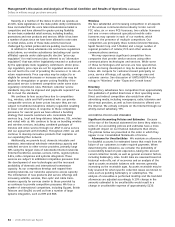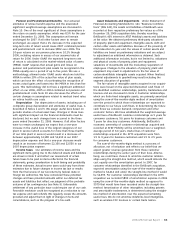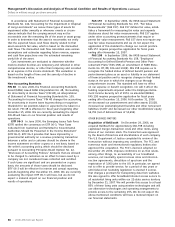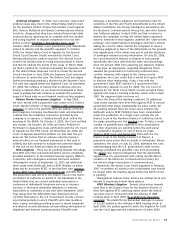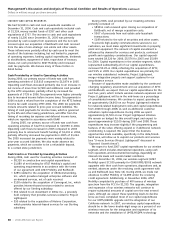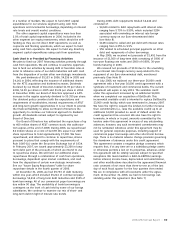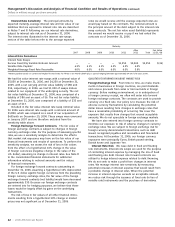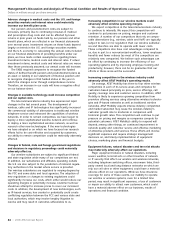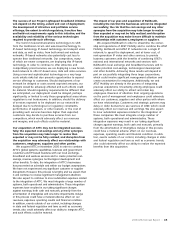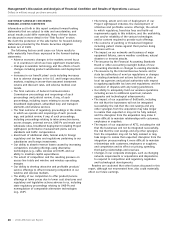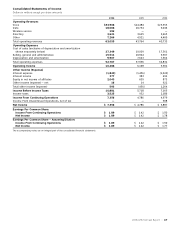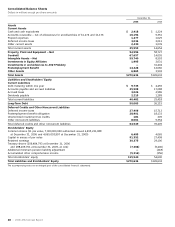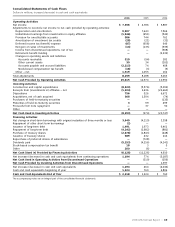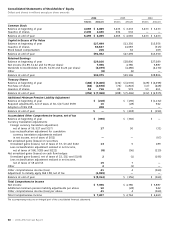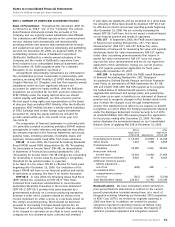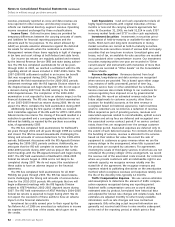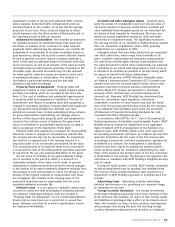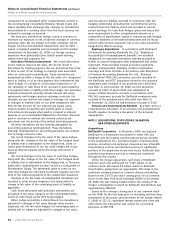AT&T Wireless 2006 Annual Report Download - page 46
Download and view the complete annual report
Please find page 46 of the 2006 AT&T Wireless annual report below. You can navigate through the pages in the report by either clicking on the pages listed below, or by using the keyword search tool below to find specific information within the annual report.
44 : :
2006 AT&T Annual Report
Management’s Discussion and Analysis of Financial Condition and Results of Operations (continued)
Dollars in millions except per share amounts
Adverse changes in medical costs and the U.S. and foreign
securities markets and interest rates could materially
increase our benefit plan costs.
Our pension and postretirement costs are subject to
increases, primarily due to continuing increases in medical
and prescription drug costs and can be affected by lower
returns in prior years on funds held by our pension and other
benefit plans, which are reflected in our financial statements
over several years. Investment returns on these funds depend
largely on trends in the U.S. and foreign securities markets
and the U.S. economy. In calculating the annual costs included
on our financial statements of providing benefits under our
plans, we have made certain assumptions regarding future
investment returns, medical costs and interest rates. If actual
investment returns, medical costs and interest rates are worse
than those previously assumed, our annual costs will increase.
The FASB required companies to recognize the funded
status of defined benefit pension and postretirement plans as
an asset or liability in our statement of financial position and
to recognize changes in that funded status in the year in
which the changes occur through comprehensive income.
Therefore, an increase in our costs will have a negative effect
on our balance sheet.
Changes in available technology could increase competition
and our capital costs.
The telecommunications industry has experienced rapid
changes in the last several years. The development of
wireless, cable and IP technologies has significantly increased
the commercial viability of alternatives to traditional wireline
telephone service and enhanced the capabilities of wireless
networks. In order to remain competitive, we have begun to
deploy a more sophisticated wireline network and continue
to deploy a more sophisticated wireless network, as well as
research other new technologies. If the new technologies
we have adopted or on which we have focused our research
efforts fail to be cost-effective and accepted by customers,
our ability to remain competitive could be materially adversely
affected.
Changes to federal, state and foreign government regulations
and decisions in regulatory proceedings could materially
adversely affect us.
Our wireline subsidiaries are subject to significant federal
and state regulation while many of our competitors are not.
In addition, our subsidiaries and affiliates operating outside
the U.S. are also subject to the jurisdiction of national regula-
tory authorities in the market where service is provided.
Our wireless subsidiaries are regulated to varying degrees by
the FCC and some state and local agencies. The adoption of
new regulations or changes to existing regulations could
significantly increase our costs, which either would reduce our
operating margins or potentially increase customer turnover
should we attempt to increase prices to cover our increased
costs. In addition, the development of new technologies, such
as IP-based services, has created or potentially could create
conflicting regulation between the FCC and various state and
local authorities, which may involve lengthy litigation to
resolve and may result in outcomes unfavorable to us.
Increasing competition in our wireline markets could
adversely affect wireline operating margins.
We expect competition in the telecommunications industry
to continue to intensify. We expect this competition will
continue to put pressure on pricing, margins and customer
retention. A number of our competitors that rely on compa-
rable alternatives (e.g., wireless, cable and VoIP) are typically
subject to less (or no) regulation than our wireline subsidiar-
ies and therefore are able to operate with lower costs.
These competitors also have cost advantages compared to
us, due in part to a non-unionized workforce, lower employee
benefits and fewer retirees (as most of the competitors are
relatively new companies). We believe such advantages can
be offset by continuing to increase the efficiency of our
operating systems and by improving employee training and
productivity; however, there can be no guarantee that our
efforts in these areas will be successful.
Increasing competition in the wireless industry could
adversely affect AT&T Mobility’s operating results.
On average, AT&T Mobility has three to four other wireless
competitors in each of its service areas and competes for
customers based principally on price, service offerings, call
quality, coverage area and customer service. In addition, AT&T
Mobility is likely to experience growing competition from
providers offering services using alternative wireless technolo-
gies and IP-based networks as well as traditional wireline
networks. AT&T Mobility expects intense industry competition
and market saturation may cause the wireless industry’s
customer growth rate to moderate in comparison with
historical growth rates. This competition will continue to put
pressure on pricing and margins as companies compete for
potential customers. AT&T Mobility’s ability to respond will
depend, among other things, on continued improvement in
network quality and customer service and effective marketing
of attractive products and services. These efforts will involve
significant expenses and require strategic management
decisions on, and timely implementation of equipment
choices, marketing plans and financial budgets.
Equipment failures, natural disasters and terrorist attacks
may materially adversely affect our operations.
Major equipment failures or natural disasters, including
severe weather, terrorist acts or other breaches of network
or IT security that affect our wireline and wireless networks,
including telephone switching offices, microwave links, third-
party owned local and long distance networks on which we
rely, our cell sites or other equipment, could have a material
adverse effect on our operations. While we have insurance
coverage for some of these events, our inability to operate
our wireline or wireless systems, even for a limited time
period, may result in significant expenses, a loss of customers
or impair our ability to attract new customers, which could
have a material adverse effect on our business, results of
operations and financial condition.


